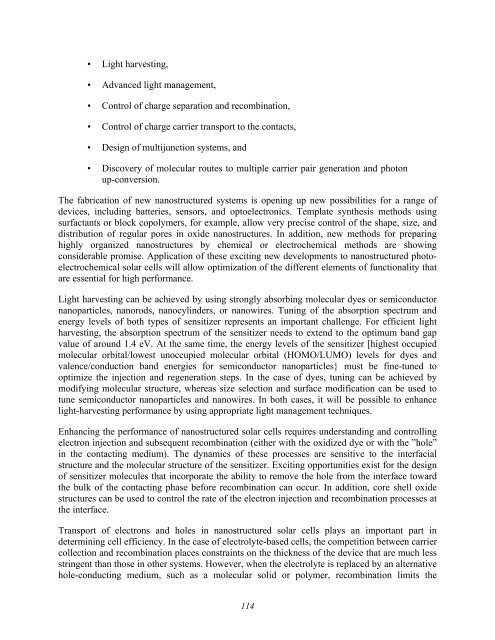Basic Research Needs for Solar Energy Utilization - Office of ...
Basic Research Needs for Solar Energy Utilization - Office of ...
Basic Research Needs for Solar Energy Utilization - Office of ...
Create successful ePaper yourself
Turn your PDF publications into a flip-book with our unique Google optimized e-Paper software.
• Light harvesting,<br />
• Advanced light management,<br />
• Control <strong>of</strong> charge separation and recombination,<br />
• Control <strong>of</strong> charge carrier transport to the contacts,<br />
• Design <strong>of</strong> multijunction systems, and<br />
• Discovery <strong>of</strong> molecular routes to multiple carrier pair generation and photon<br />
up-conversion.<br />
The fabrication <strong>of</strong> new nanostructured systems is opening up new possibilities <strong>for</strong> a range <strong>of</strong><br />
devices, including batteries, sensors, and optoelectronics. Template synthesis methods using<br />
surfactants or block copolymers, <strong>for</strong> example, allow very precise control <strong>of</strong> the shape, size, and<br />
distribution <strong>of</strong> regular pores in oxide nanostructures. In addition, new methods <strong>for</strong> preparing<br />
highly organized nanostructures by chemical or electrochemical methods are showing<br />
considerable promise. Application <strong>of</strong> these exciting new developments to nanostructured photoelectrochemical<br />
solar cells will allow optimization <strong>of</strong> the different elements <strong>of</strong> functionality that<br />
are essential <strong>for</strong> high per<strong>for</strong>mance.<br />
Light harvesting can be achieved by using strongly absorbing molecular dyes or semiconductor<br />
nanoparticles, nanorods, nanocylinders, or nanowires. Tuning <strong>of</strong> the absorption spectrum and<br />
energy levels <strong>of</strong> both types <strong>of</strong> sensitizer represents an important challenge. For efficient light<br />
harvesting, the absorption spectrum <strong>of</strong> the sensitizer needs to extend to the optimum band gap<br />
value <strong>of</strong> around 1.4 eV. At the same time, the energy levels <strong>of</strong> the sensitizer [highest occupied<br />
molecular orbital/lowest unoccupied molecular orbital (HOMO/LUMO) levels <strong>for</strong> dyes and<br />
valence/conduction band energies <strong>for</strong> semiconductor nanoparticles} must be fine-tuned to<br />
optimize the injection and regeneration steps. In the case <strong>of</strong> dyes, tuning can be achieved by<br />
modifying molecular structure, whereas size selection and surface modification can be used to<br />
tune semiconductor nanoparticles and nanowires. In both cases, it will be possible to enhance<br />
light-harvesting per<strong>for</strong>mance by using appropriate light management techniques.<br />
Enhancing the per<strong>for</strong>mance <strong>of</strong> nanostructured solar cells requires understanding and controlling<br />
electron injection and subsequent recombination (either with the oxidized dye or with the ”hole”<br />
in the contacting medium). The dynamics <strong>of</strong> these processes are sensitive to the interfacial<br />
structure and the molecular structure <strong>of</strong> the sensitizer. Exciting opportunities exist <strong>for</strong> the design<br />
<strong>of</strong> sensitizer molecules that incorporate the ability to remove the hole from the interface toward<br />
the bulk <strong>of</strong> the contacting phase be<strong>for</strong>e recombination can occur. In addition, core shell oxide<br />
structures can be used to control the rate <strong>of</strong> the electron injection and recombination processes at<br />
the interface.<br />
Transport <strong>of</strong> electrons and holes in nanostructured solar cells plays an important part in<br />
determining cell efficiency. In the case <strong>of</strong> electrolyte-based cells, the competition between carrier<br />
collection and recombination places constraints on the thickness <strong>of</strong> the device that are much less<br />
stringent than those in other systems. However, when the electrolyte is replaced by an alternative<br />
hole-conducting medium, such as a molecular solid or polymer, recombination limits the<br />
114
















